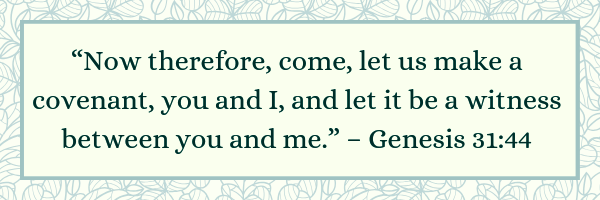The concept of “covenant” has been revolutionized by research in recent decades of studying the Old Testament. What is the idea of covenant in the Bible?
Many scholars, whether conservative or liberal, have maintained that “covenant” is the organizing principle around which Old Testament theology must be constructed and understood.
It has become clear that in the near eastern world of the second millennium before Christ, formal covenants were the primary way people who were not blood relatives related to one another.
The Meaning of Covenant
The word “covenant” basically means “contract;” it is an agreement between God and His people. In the said agreement, God makes promises to His people and usually requires certain conduct from them.
As used in Scriptures, the word “covenant” is the Hebrew word “Berith” which means “to cut or divide.” This is an allusion to the Jewish sacrificial custom in connection with covenant-making, where the two parties involved would divide the animal by which the covenant was ratified and laid them out in two halves.
After that, the contracting parties would then “walk between the pieces” to establish the covenant.

In the Greek Septuagint, covenant is the Greek word “Diatheke.” Unlike Hebrew, the Greek differentiates between a covenant where one party is the recipient (diatheke) and the other the benefactor, and other covenant made between equal parties.
If the two parties come together in agreement, making it a two-way arrangement, the word “Suntheke” is used, which means “to place together.”
Of Meals and Marriages
People in Asia Minor, ancient Mesopotamia and first century Palestine depended on covenants to appease the gods, regulate personal affairs, international relations and business deals. All kinds of covenants existed between equal partners, between greater and lesser partners, and between absolute sovereigns and object servants.
Covenants were often memorialized with stone pillars (stellae) as Jacob and Laban did (Genesis 31:44-47). A ceremonial meal between the parties involved would signify the harmonious nature of the new relationship and a marriage between the two families seals the compact.
In every case, the gods of all parties involved were called to witness and guarantee the contract, agreement, vow or treaty.
Fortunately for Bible scholars, the people of the ancient Near East went out of their way to write down all kinds of covenants. All during the twentieth-century archaeologists dug up, dusted off, and deciphered clay tablets and stone monuments that recorded countless covenants regulating the commercial, political and religious life of nation after nation.
Perhaps the most significant covenants for Old Testament studies turned up in the archives of the Hittite monarchs, which were discovered in 1906 among the ruins of Boghaz-koi in Turkey.
*Related Article: What is the Adamic Covenant?
The Covenant Form
It has been demonstrated quite conclusively by Meredith Kline and others that the structure of the Hittite treaties between oriental monarchs and their abject vassals parallels in close detail the covenant format between Yahweh and Israel found in Exodus chapters 20 to 23, Joshua 24 and the Book of Deuteronomy.
When the one, true living God initiated a relationship with the descendants of Abraham, He utilized a covenant style universally understood at the time:
- a preamble identifying the absolute sovereign
- a brief history of relations between the absolute sovereign and the subject people
- the benefits for and obligations of the subject people
- an oath of allegiance and its accompanying blessings for obedience
- a list of witnesses and directions for keeping the covenant
At times there followed instructions for periodic renewal of the covenant.
The Old and New Testament
The Bible is divided into an Old Testament and a New Testament. “Testament” was a synonym for “covenant” in the English era of King James I. All of God’s Word concerns an old and a new form of the way in which He provides for a personal, mutually committed relationship between Himself and those who He calls and who respond in faith to Him.
Various other biblical covenants predate the “old covenant” or elaborate aspects of it. People of God’s covenant have a basis for saying, “My beloved is mine, and I am his” (Song 2:16).
*Reference: NKJV Prophecy Study Bible, 2015 Edition
Understanding God’s Message in the Last Days
General Editor: John Hagee
The prophecies of the Bible assure us that God will prevail. The NKJV;Prophecy Study Bible, 2015 Edition; has hundreds of pages of special features that offer a broad understanding of prophetic themes, salvation, covenants, and other important doctrines of the Christian faith.
Features include:
- Introduction to Bible Prophecy
- Index to Prophetic Passages
- Top 20 Questions about Bible Prophecy
- Diamonds for Daily Living
- Evidences
- Spokesmen for God
- Bible Insights
- Bible Prophecy Charts
- Full concordance

